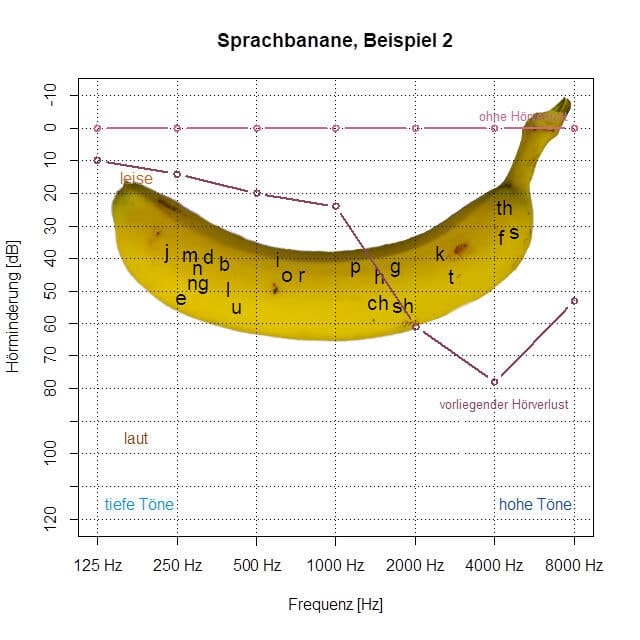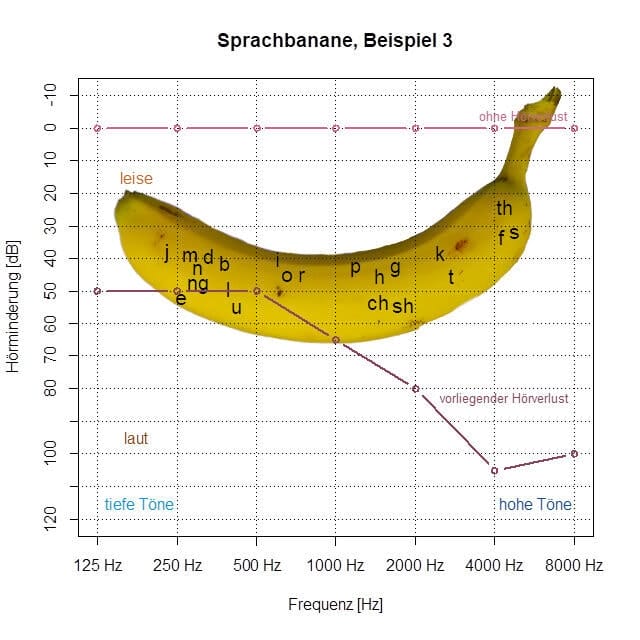Hearing and hearing aids
Sound and speech audiogram
When we talk about speech here, we mean the spoken language that is transmitted from the mouth of a speaker to the ear of a listener. Visually transmitted speech such as writing or signing is not considered in hearing acoustics.
The human voice and the sensitivity of the human ear are perfectly matched. First and foremost, the human voice covers a wide range of pitch and volume that can be optimally picked up by the human ear. In contrast to written language, spoken language not only provides us with information about content, but also tells us something about the mood and emotional state of the person speaking. Oral communication in humans developed about 40,000 years ago.
It's therefore more than understandable that the main desire of people with hearing impairment is to understand speech, if possible also in noisy environments. In addition to sound audiometry, which measures the loss of hearing sensitivity for sounds, speech audiometry therefore measures the impairment in understanding speech. The result of this measurement is also included in the hearing aid fitting.
Loud
The smallest units of spoken words are represented by sounds. There are far more sounds than the alphabet of a respective language offers. From our school days we know that in the German language sounds are divided into vowels and consonants. Other languages, e.g. East African, know click sounds, which do not occur at all in our language and would require some practice for us to be able to speak them.
Vowels
The term is derived from the Latin "vocalis" and means "sounding letter". In German languages, these include the letters "a", "e", "i" "o", "u", "ä", "ö" and "ü". Vowels are also called vowels. They transmit a significant amount of acoustic energy due to low frequencies and a majority open mouth. Therefore, they are often used for loud calls. Vowels alone are less suitable for transmitting complex information. For this, the consonants are additionally needed.
Consonants
For unambiguous linguistic communication, the language requires above all the high information variety of the consonants. The term is derived from the Latin "consonare", which means "to sound". Consonants transmit a great deal of information based on high-frequency vibrations, but have only limited sound energy. For example, "g" or "p" are not at all suitable for loud and powerful calling. The specific characteristics of consonants are higher than 1000 Hz. In the speech audiogram, consonants are tested over one-syllable words. For example, someone who has problems distinguishing the word "almost" from "juice" suffers at least from a restriction of perception in the high frequency range.
Sound audiogram Speech audiogram Speech banana
The tone audiogram measures the hearing ability for tones, i.e. the frequency-dependent hearing sensitivity of a person. The result is presented as a difference curve to the zero line of a so-called standard hearing curve. In the speech audiogram, the understanding of two-digit numbers, one-syllable words or even meaningless syllables can be tested. Sound and speech audiograms together show whether and what type of hearing impairment is present.
So if you've communication problems in noisy surroundings or, for example, in a babble of speech at a cocktail party, it is best to have your hearing checked without obligation at one of our branches of HZ Hörmittelzentrale Nordwestschweiz. Using the so-called speech banana, our acousticians can explain your specific hearing impairment and show you possible solutions.

Example 1
Sound and speech audiogram
- Name: Elvira Gessler
- Age: 51 years
- Occupation: Receptionist
- Free time: likes to go to the cafe
- Problem: Increasing difficulties with speech intelligibility
- Cause: incipient age-related hearing loss (presbycusis)
- Language Banana: Problems with "f", "th" and "s

Example 2
Sound and speech audiogram
- Name: Francesco Fontana
- Age: 62 years
- Occupation: Building tradesmen
- Free time: he spends with his grandchildren
- Problem: Tinnitus, overhears calls and alarm signals
- Cause: Age-related hearing loss and damage due to construction noise
- Language Banana: Problems with "f", "th", "s", "k", "g", and "sh"

Example 3
Sound and speech audiogram
- Name: Albert Meier
- Age: 83 years
- Occupation: Pensioner
- Free time: likes to listen to music
- Problem: Age-related hearing loss, significant communication problems
- Cause: Age-related hearing loss ,poorly treated middle ear infections in childhood
- Language Banana: Problems with almost all consonants
